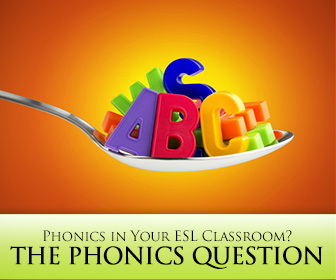Ghoti is Fish? 6 Reasons to Teach Phonics in the ESL Classroom


I know my linguistics program taught that phonics was not a good choice for ESL students. Then I worked at a school where phonics was required for all students, especially those studying English. Today, traditional classrooms are pushing for sight words and deemphasizing or totally eliminating phonics. For ESL teachers, the question of whether to use phonics with students learning English is sometimes a difficult one to answer. Though much of English follows phonetic rules, sometimes the exceptions seem be in greater numbers. Do the drawbacks of phonics outweigh its benefits? Is phonetics a better way to teach pronunciation and reading? Or will it do ESL students more harm than good? If you are struggling with the phonics question, as I have, here are some of the plusses and minuses attributed to phonics to consider as you answer the phonics question for yourself.

Phonics is helpful for students who are just learning the English alphabet. Students whose first language does not use the same alphabet as English does (Japanese, Chinese, Korean, Arabic, Hebrew, etc.) have an extra challenge as they learn English. They are learning a new alphabet and the sound that are associated with it. For these students, phonics can be a great help. Students learn what sounds each letter or combination of letters makes, and that helps them in their reading and pronunciation, especially with new words.
Because it helps students break down words into their components, phonics helps students become better spellers. They are able to sound through each part of a word and determine the letters needed to write it.
Students of phonics are also better at reading unfamiliar words. They can sound out the letters and letter groups in new vocabulary and often accurately pronounce them on the first try.
Because phonics enables students to see phonemes within words, students who learn phonics may have an advantage to decoding English words from their word roots. They may recognize spelling patterns more easily and make connections between spelling and meaning. This may help them when they encounter new words that follow the spelling patterns they already know.
Learning phonics can give your ESL students a boost in their confidence as well. When learners have the tools (in this case the rules of sound and spelling in English) they will gain a certain confidence because they have the tools they need for success. This success will increase your students’ confidence which will spill over from reading and spelling into other areas of language learning. Because one key to language learning success is the courage to use the language that you know, students with the confidence boost that comes from learning phonics may find themselves bolder and more willing to experiment with English in other language situations.

ESL students who become successful at phonics may become what is known as false readers. They may be able to read aloud easily and pronounce unfamiliar words when they encounter their written forms. But for ESL students, comprehension is far more than reading a word on a page. For students of English, seeing and understating a word in meaningful context is essential. Therefore, ESL students who are successful at learning phonics may seem to understand what they are reading, but in reality know nothing more than a word’s pronunciation. If students cannot understand a word’s meaning in context and use that word appropriately, they do not really know it. False readers, then, seem to understand and read a word when in reality they do not know the word and are unable to use it.
Phonics is a linking strategy. For native speakers, particularly children learning to read, phonics helps them recognize in writing words they already know in their aural form. ESL students do not have that base knowledge of vocabulary because, unlike native speakers, they have not been using English fluently for years before they learn to read. Being able to read and pronounce a new word does not necessarily allow the ESL student to link it to previous experience with that word. Native speakers may have a different result when they use phonics to read a word correctly. They already know the words though they are not familiar with the written form. Though phonics is a benefit to native speakers in recognizing the written forms of words they already know, ESL students will not find this same effect from phonics.
Though phonics does teach the rules of spelling and pronunciation, English sometimes seems to be composed more exceptions than words that follow phonics rules. Your students can become frustrated when they depend solely on phonics as a reading and spelling strategy. Because pronunciation of English words has changed over decades while spelling has remained the same, your students will need to understand and be patient with the myriad exceptions in English. Students must also be careful when learning new words. In some cases, using phonics to decode an unfamiliar word will result in incorrect pronunciation of that word because it is an exception to the rules of phonics.
Teaching phonics requires a lot of work on the teacher’s part. You must constantly label and point out the letter patterns in words and help your students recognize and remember them. If you teach phonics, it will become a part of not only every day’s material but each lesson itself. You will have to show the phonic breakdown of every new vocabulary word your students learn until they are able to do it themselves (which can take a year or more).
Phonics has significant advantages as well as disadvantages for the ESL student, and every teacher must determine for himself or herself whether to use it in the classroom. Ultimately, no one system will be enough to teach your ESL students flawless use of English. Most ESL teachers find that a balanced program best serves their students. Emphasizing the oral aspect of language – speaking, listening, phonology – will help students of phonics develop a more well-rounded and more effective English learning strategy. Each teacher will find the balance that is right for him or her with a little effort and some experimentation. It will be up to you to find the right balance for you.